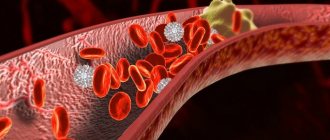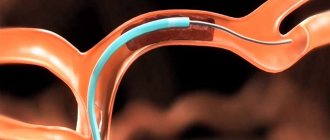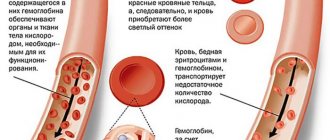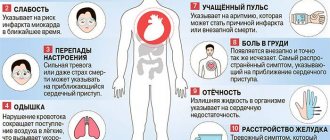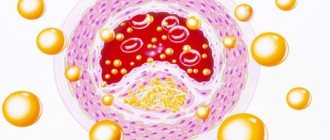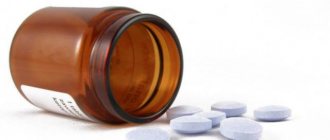A person cannot independently find out whether there is a blood clot. Read the article, it describes diagnostic methods and the first signs of thrombosis.
A thrombus is a collection of white blood cells, red blood cells and platelets that form a clot that blocks the flow of blood. Localized in the veins and arteries of various organs. If a blood clot blocks a vein or artery, it is a major health hazard and can even be fatal. In this article, we will look at how to find out if there is a blood clot in the body, how to diagnose it, and how to help a loved one if the blood clot has broken loose.
Causes, symptoms, thrombophlebitis, prognosis
This serious disease can be caused by vein injuries, varicose veins, infectious, autoimmune processes in the body and developing atherosclerosis.
- The main signs of developing thrombophlebitis are heaviness in the muscles, swelling, and a bluish tint to the skin.
- In later stages, painful, bluish-purple, hardened venous nodes are visible, which can open and bleed, forming non-healing ulcers.
- It is important to know: the disease can lead to the death of the patient due to the detachment of a blood clot (thomboembolism), if the detached blood clot completely blocks the pulmonary artery or other important vessels.
- If left untreated, thrombophlebitis can cause limb loss, disability, and even death due to tissue necrosis.
- The development of blood clots in other parts of the body is also very dangerous.
The first signs of blood clots
A thrombus is a cause of disruption of blood flow in arteries or veins. The first symptoms of a blood clot in the body:
- The sudden appearance of a dull, bursting pain in the veins of the legs,
- The skin takes on a bluish-red hue,
- Skin tightness
- There is a sharp pain when lowering your legs,
- Burning sensation.
The cause of blood clot formation in superficial vessels is most often inflammation. This process accompanies:
- sweating,
- General weakness
- Increased body temperature.
If blood clots have formed in the area of deep vessels, then the initial symptoms are not observed due to the absence of an inflammatory process. You can find out if there are blood clots in the body by regularly examining your feet. In this case, it is worth paying attention to the heterogeneity of the skin. The problem can be detected by palpation. In problem areas, swollen muscles are noted, superficial veins appear as a mesh. A large blood clot reveals itself by the blue color of the skin.
Important symptoms of vascular thrombosis
Thrombosis of abdominal vessels
It is important to know the main symptoms of vascular thrombosis:
- Lower extremities - sharp pain, loss of sensitivity, cooling of tissues.
- Abdominal arteries - abdominal colic, nausea, vomiting, loose stools.
- Pulmonary artery - unbearable pain in the chest, coughing up blood, arrhythmia.
- Cerebral arteries - sharp pain in certain parts of the head, loss of vision, dizziness, nausea.
- Cardiac coronary arteries - sharp pain in the heart during emotional or physical stress.
- It is important to know: secondary signs of circulatory problems - malaise, chills and muscle pain - can be confused with a cold or flu.
Tip 2 What is a blood clot in the leg
Quite often there is a disease such as thrombosis of the veins of the legs. With it, the veins become clogged and blood cannot move freely through them. Due to a violation of the outflow of blood, it stagnates with swelling and blueness of the skin in the place where the blood clot has formed in the leg. Thrombosis can, if separated from the venous wall, lead to blockage of the lumen of the pulmonary artery. In this case, a dangerous disease occurs - thromboembolism.
Inflammation of the vein can also lead to a blood clot blocking the veins. Then thrombophlebitis occurs. The main signs of a blood clot in the leg: swelling, pain, increased body temperature of the patient. Thrombophlebitis is often a consequence of varicose veins in the legs. Diagnosis of the presence of thrombosis is carried out on the basis of symptoms and ultrasound examination of the veins, as well as venography, MRI.
Thrombophlebitis, in which a blood clot forms in the leg, is treated with medications and agents that can reduce blood clotting. If the disease is not treated, a detached blood clot in the leg can travel to the heart and blood vessels, which in practice often leads to various serious complications, including sudden death.
There are several reasons for the formation of blood clots. Thrombosis occurs if, for example, a person does not move for three days or more (for example, after surgery) or is immobilized for a long time (for example, paralyzed patients with a long absence of movement). Long-term dehydration can also increase blood viscosity. It can be caused by lack of fluids in hot weather, burns, and various infectious diseases. Blood clotting disorders can occur due to the presence of cancer of various organs. Sometimes it can be congenital, that is, acquired in the womb.
To prevent the formation of thrombosis, it is necessary to exclude the main risk factors. If there are several risk factors, then in this case the doctor must prescribe a certain set of medications and methods that will prevent the development of thrombosis.
Among the risk factors are the following: old age, overweight, the presence of tumors of various types, prolonged absence of movement in the legs for three or more days, long trips, long-distance air travel, pregnancy and recent childbirth, diseases and disorders of the cardiovascular system. systems.
Sometimes thrombosis can be asymptomatic or manifest itself with a number of symptoms at once. This may be swelling in the lower third of the leg (calf area), pain when moving, especially when bending the foot, increased sensitivity of the skin of the leg.
Treatment of thrombosis depends on factors such as the cause of the disease, age, etc. If the blood clot is securely attached to the wall of the vein, then drug treatment is prescribed, and if there is a risk of it breaking off, a thrombectomy (surgical removal of the blood clot) is performed. If thrombosis is present, patients should remain in bed.
The acute form of thrombosis requires immediate surgical intervention, especially for patients with diseases that directly threaten the functionality of the limbs. In other cases, it is advisable to carry out conservative treatment after a complete examination of the patient’s health status. The earlier the course of treatment begins, the more effective the result and the fewer negative consequences and complications occur after venous disease.
How to check blood vessels for blood clots
If the symptoms described above appear, consultation with a phlebologist is mandatory.
- It is necessary to take a coagulogram - a blood test for clotting.
- Blood test for cholesterol and lipid profile.
- Blood test for glycated hemoglobin and sugar.
- You need to undergo hardware diagnostics:
- phlebography, plethysmography,
- Ultrasound,
- duplex scanning of blood vessels -
- - head, neck, abdominal cavity, leg vessels.
- Echocardiography,
- Coronary angiography of the heart vessels.
- Special MRI.
- Computed angiography.
- The results will show where the blood clot is located and in which areas of the vessels the blood circulation is impaired.
- This will help the doctor assess the likelihood of developing thrombosis and make an accurate diagnosis.
- Identify the cause of the disease.
Types of analyzes
To detect the presence of vascular thrombophlebitis, it is recommended to conduct the following types of studies:
- CBC (complete blood count). It is done in the morning on an empty stomach. This study shows how all the cells in the blood work. It determines the amount of hemoglobin and other substances. Normally, the platelet count should vary between 200-400. Women may experience slight deviations during pregnancy or menstruation,
- An advanced analysis will determine the rate of blood clotting,
- A coagulogram for thrombosis is performed simultaneously with an ultrasound. This will help locate the clot. To determine whether a blood clot is present, venous blood is taken and mixed with citrate. After taking the material, it is divided into several parts and sent to a water bath. It is important to accurately determine the time required for complete clotting. Normally, it should not exceed 10 minutes. This analysis not only allows you to determine whether there is venous thrombosis, but also determines the type of platelet. It happens that the CBC shows a normal platelet count, and when performing a coagulogram, the dominance of a certain group of platelets is determined. In this situation, it will not be possible to detect the problem using the UAC,
- To detect thrombosis, you will need to do a C-reactive protein test. This indicator determines the presence of an inflammatory focus in the veins. C-reactive protein found in plasma accurately indicates inflammation, which subsequently leads to thrombophlebitis. This analysis is one of the most informative, since it detects even the slightest changes in the protein. The normal amount of C-reactive protein is from 0 to 10. If it is exceeded, one can assume the presence of an inflammatory process in the vein and suspect thrombosis,
- Enzyme immunoassay determines infectious processes that caused inflammation of blood vessels, identifies cancer, and hormonal imbalance. During the study of the material, antibodies that form in the blood are studied. The serum produced in the body at the time of blood clotting is tested. The reaction is determined depending on the color of the serum and is checked in accordance with the scale,
- An INR (international normalized ratio) test determines the time at which blood clots form while taking anticoagulants for the treatment of vascular thrombophlebitis and without them. During this procedure, PTI (prothrombin time) is determined, which ranges from 70 to 100 units. In a patient taking anticoagulants, it varies from 24 to 42.6 units. If elevated levels are diagnosed, the risk of stroke from thrombosis increases. A decrease in PTI indicates the possibility of bleeding,
- To find out the genetic predisposition of vascular thrombophlebitis, molecular genetic analysis will be required. To diagnose hereditary predisposition, a PCR (polymerase chain reaction) examination is carried out, which determines the degree of coagulation at the genetic level.
During a blood test, only half of the cases of venous thrombosis are detected. If the result shows the likelihood of the disease, the doctor will order a test to determine the genetic nature of thrombophlebitis.
On a note!
If, when taking an OAC, there is a suspicion of venous thrombosis, then other blood tests and ultrasound will be required to accurately determine the presence of vascular thrombophlebitis and the location of the blood clot.
Tests that can help identify blood clots
Thrombophlebitis during pregnancy
To diagnose thrombosis, a phlebologist prescribes laboratory tests.
- You will need to do a general blood test and
- biochemical blood test for C-reactive protein,
- Do coagulography.
- To clarify hemostasis, your doctor may recommend tests.
Coagulographic study
This research method is called that because it tests the blood’s reaction to a special anticoagulant substance.
A coagulogram is carried out as follows: before breakfast, in the morning, 5 milliliters of blood is taken from a vein in the elbow and placed in a small container with an anticoagulant.
This test allows you to check the activity and interaction of all types of platelets, detects blood clotting failures, and the presence of blood clots. As a rule, a coagulogram is prescribed in combination with ultrasound of the vessels of the extremities.
If a blood clot is suspected, a coagulographic analysis may also have the following interpretation:
- The level of fibrinogen in the blood - proteins that affect the rate of blood clotting. Any deviation of this indicator from the norm indicates a violation of this important process.
- Thrombosed time, i.e. rate of platelet aggregation.
- Prothrombin index, i.e. the difference between the blood clotting time of a healthy and sick person.
All these characteristics determine the likelihood of blood clots, the appearance of new clots, the tendency of blood to form clots, and other characteristics.
The price of this analysis in private clinics is about 200 rubles.
What is a coagulogram
Thrombophlebitis of blood vessels of the hand
A comprehensive blood test to assess coagulation is important for diagnosis. The results of the study allow the doctor to evaluate the indicators of platelets, fibrinogen and prothrombin:
- C-reactive protein,
- prothrombin time, PTI, antiprothrombin,
- D-dimer and other parameters.
- They may vary in different laboratories; only the attending physician can evaluate the results.
Preparation for the procedure
A blood test for thrombophlebitis allows you to determine the following indicators:
- Inflammatory process in the veins,
- Immunity status
- Presence of cardiovascular diseases,
- Problems with blood clotting.
A blood test can be done for all people, without exception. To accurately determine thrombophlebitis using a blood test. Simple preparation for the procedure is recommended:
- On the eve of the study, you should avoid eating fatty, fried, spicy foods,
- Before diagnosis, it is important to exclude any alcoholic drinks for 2 days,
- You are not allowed to smoke on the day of the test.
- The analysis takes place on an empty stomach,
- The last meal is recommended no earlier than 8 hours before the procedure,
- Before the procedure, any physical and emotional stress is excluded,
- If the patient uses anticoagulants to eliminate venous blood clots, then he needs to inform the laboratory assistant about this,
- In case of dizziness, it is necessary to inform a specialist and carry out the procedure while lying on the couch,
- If you have chronic diseases, you should not take medications in the morning.
Interesting!
If the test results for venous blood clots are higher than normal, this indicates the formation of clots.
Features of blood tests for thrombophlebitis
- In cases of thrombophlebitis, an acceleration of ESR and leukocytosis will be observed.
- Fibrinogen concentration will increase,
- the reaction to C-reactive protein is positive.
It is important to know that neither general nor biochemical tests can reliably confirm thrombosis. Even the determination of D-dimer can show its increase in physiologically normal patient conditions.
How to determine cholesterol plaques in blood vessels by measuring carotid artery IMT
To determine cholesterol plaques in the carotid artery (which is incomparably easier to reach than the coronary vessels), the patient only needs to lie quietly on the couch for 10 to 12 minutes. The procedure itself boils down to an ultrasound examination of the carotid artery: a special gel is applied to the neck, and the doctor takes about 12 photographs of the right and left arteries from different angles.
The resulting images are processed on a computer. The measurement accuracy is several hundredths of a millimeter. The obtained values are compared with the average statistical values - and from this comparison one can, for example, estimate the age of the circulatory system. The procedure for high blood cholesterol levels should be repeated every 1 to 2 years (to assess changes in plaque size).
Regular observations make it possible to predict the risks of complications and adjust diet and lifestyle to the needs of the cardiovascular system. An alternative to changing IMT in terms of accuracy is only invasive (internal) angiography procedures.
An analysis that will determine genetic thrombophilia
The risk of this pathology can be determined using a special molecular genetic analysis.
- Genetic factors affecting platelet receptors, fibrinolysis, coagulation, and folic acid metabolism are assessed.
- These indicators will help assess the hereditary tendency to blood clot disorders.
- The material for the study is taken from a vein, as well as in vitro epithelium in the cheek area.
- No special preparation is required for this test.
Efficiency of analyzes
Many patients are interested in the question of whether it is possible to determine thrombosis using a blood test. An analysis for vein blood clots is used to accurately diagnose a number of pathologies, which include vascular inflammation, decreased immunity, cardiovascular diseases, and problems with blood clotting.
With the help of standard blood donation, you can make a timely diagnosis and prescribe treatment, which will allow you to avoid serious complications that arise from the formation of blood clots in deep vessels. The sooner the problem is detected, the greater the chance that the disease will not progress and become incurable. By regularly taking tests, treatment can be adjusted by choosing the most effective therapy.
Features of analysis for hepatitis
If a person is sick with hepatitis, the results obtained are always below the normal level.
- Such a patient will have a low platelet count,
- increase in leukocytes,
- low hemoglobin.
- This is a clear clinical sign of the onset of venous thrombosis.
Treatment, medicinal and surgical
During drug therapy, patients are prescribed blood thinners:
- disaggregants,
- anticoagulants,
- symptomatic remedies,
- phlebotonics of plant origin,
- vitamin injections.
Surgical methods for the treatment of thrombophlebitis are routinely used for medical reasons:
- If there is a threat of tissue necrosis,
- When the deep veins are affected, patients undergo emergency surgery.
- After an ultrasound scan, sections of veins with varicose veins are removed.
- Additional measures:
- diet therapy,
- medical compression garments,
- moderate physical activity.
Norm and deviation
The results obtained are compared with the following standards:
- The CBC shows the average platelet count, which normally should be 200-400. The rate is higher in men than in women, especially during pregnancy,
- The coagulogram shows the amount of fibrinogen, prothrombin index, and clotting time. The normal value of fibrinogen varies from 2 to 4 g. per liter Decreased readings are evidence of a blood clotting disorder, elevated readings indicate the formation of vein blood clots and impaired vascular integrity. The prothrombin index should be within 95-105%. Clotting time in a healthy person is 38-55 seconds,
- The normal amount of C-reactive protein is no more than 10 mg per liter. An increase in this number indicates the presence of an inflammatory process in the superficial and deep veins. Its amount begins to increase within 6 hours from the onset of inflammation,
- The standards for assessing INR (international normalized ratio) may be different. Before surgery, it should not exceed 1.25 units. In a patient undergoing treatment for vascular thrombophlebitis, the INR may vary from 2 to 3 units. If during diagnosis the indicator rises above 6 units, then the patient needs immediate hospitalization, as he has a high risk of developing internal bleeding. Its decrease indicates a lack of vitamin K, prothrombin, and an increase in blood clotting in pregnant women, which is not a pathology.
If the patient belongs to the risk group, there is a high risk of developing thrombophlebitis, then with the help of a blood test it is possible to prevent the formation of a vein thrombus and avoid serious consequences that lead to death.

